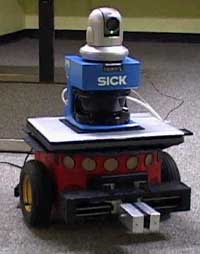 | ||
 |  | |
| To date, our work with Ripley (an interactive manipulator robot) has focused on performing isolated actions in highly controlled contexts. Animals in the real world, in contrast, can sustain life only by juggling multiple, conflicting goals, all vitally necessary, that must be kept in balance. The goals themselves may be an important part of the cognitive experience - humans are constantly aware of the motivations for their actions. For this reason, we have begun to implement a control strategy for Ripley that simultaneously pursues multiple top-level goals, in order to explore the connection between actions and their motivations. Ripley's three top-level goals are 1) keep motors cool; 2) explore and be aware of the immediate environment; and 3) carry out spoken commands from humans. These goals are sometimes in conflict. Heightened awareness (goal 1), for example, requires constant surveying of the environment, which leads to hot motors (conflicting with goal 2). This project explores planning algorithms that enable Ripley to balance goals through rational action. |
 |
